by Mike Bendzela
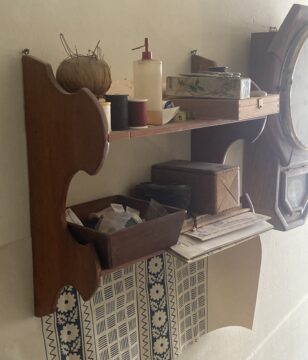
One of the last of the traditional wood craftsmen in New England was born in the nineteen-fifties outside Boston, appropriately, historic home of many spindle turners and chair caners, lumber joiners and paint-stainers. His most vivid memories of the period involve his grandmother’s house in Cambridge, including the smell of cabbage from her tenants boiling dinner in their kitchenettes. After his parents’ marriage and his birth, the family lived on the first floor of her house for several years before moving further out of town. Unbelievably, even though he would have been only around two years old at the time, he remembers the fancy wallpaper that was still in the room and all the original woodwork having been painted white from earlier owners who had tried to un-Victorianize the old house.
Throughout his childhood he would frequently visit his grandmother’s house, and he can describe the layout of the place even though he was less than eight years old at the time. The structure was a late nineteenth century three-storey, mansard-roofed tenement building that was originally a single-family home with a carriage shed. The second floor consisted of three great rooms with double doors that his grandmother shared with tenants. His father had built a wall to make a little room four feet wide between two big rooms to function as a kitchenette for one of the tenants. The room he stayed in as a boy on the third floor was only large enough to accommodate a three-foot wide bed, an armoire, and a chair. He understood at the time that the room’s small size corresponded to the layout of the bathroom below and that the diminished ceiling was caused by the pitch of the mansard roof above. He claims to be able to draw the entire house from memory to this day.
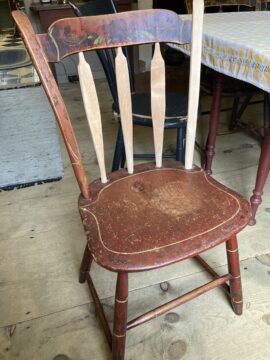
His grandmother took him on walks along the main drag that led to Harvard Square, where he would observe all the houses with woodwork much more elaborate than on the new house he now lived in with his parents. These houses had lots of fancy trim, porches, and columns that were substantial. He and his grandmother would pop into the secondhand shops that had antique furniture in them, and she would let him roam around and see what was there. On Sundays, his parents took him to museums in Boston that contained furniture he really took a liking to. He could examine things closely as they were not quite so fussy back then about people looking at things. He could get down on his hands and knees and look underneath pieces to see how they were glued together or blocked or maintained. Out of the corner of his eye he could see the museum guards looking at him wondering what the hell he was doing, but they never interrupted him because he wasn’t opening drawers or otherwise touching anything.
His earliest carpentry project was his idea of a grandfather clock that he made out of pieces of wood strapping and scrap two-by-fours. It stood about six feet tall and was only about six inches deep, but in his mind it was functional. His parents let him put it in the living room for about a week.
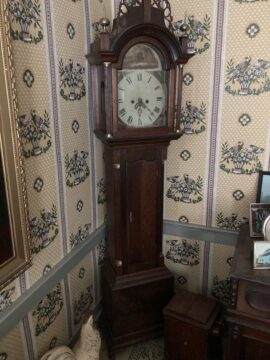
Right up through high school, he did not work with anyone or even know anyone who made furniture, which makes you wonder about the eerie, blurry line between learning and instinct. Luckily, his school had a good wood shop, in which the teacher actually taught students techniques in how to maintain a house. Realizing his skills were above the others in the class, the teacher allowed the young artisan to do what he wanted. He could look at something and make a copy of it, maybe a bit crudely, but he got better at reproducing the exact size and shape and eventually even the quality. He made a bookcase in Gothic style to house antique books he had been collecting, copied after the bookcases in the Concord library. It consists of four pieces, seven-and-a-half feet tall, totaling about eight feet long. It has a walnut veneer and solid walnut trim, unlike anything anyone else was building, even with an altar-like carrel in the middle for placing books on.
He had embarked on his first construction project when he was about 12 or 13 years old, a sort of clubhouse he built with friends, starting out as an eight-foot-square wood platform with a four-foot tall first floor. Because so many new houses were going up in Concord at the time, the construction workers would allow the boys to haul off scrap lumber and cuttings to put together these clubhouses. The young craftsman directed these building projects, using that eight-by-eight platform for a number of structures. The final clubhouse ended up being four stories tall, about sixteen feet, with a two-floor bay window in the corner of the building. When town authorities got wind of the project, they made the boys take off the top two floors. This was prudent as the clubhouse did not have a foundation, and when the wind blew the boys could feel their building swaying back and forth.
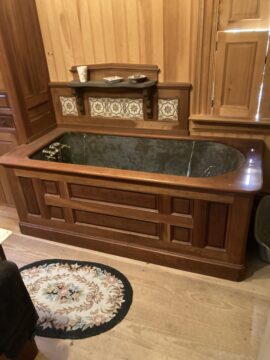
His diverse interests manifested themselves when he worked at the Concord Public Library throughout high school. He took care of the building and even became a custodian when the regular one went on vacation. He did some refurbishing of the second floor gallery, moving a wall over one foot and installing lighting under some moldings to illuminate the books. He had to paint the entire basement, walls and floors, which required moving out 3000 books, going through 30 gallons of paint, and having to put all the books back in place, in proper order. Meanwhile, he continued collecting books and antiques, he liked to cook and bake for his family, and he was an instinctive mechanic who repaired and restored old cars with his younger brother.
When asked what it was about woodworking that held his interest instead of something more modern and lucrative, like car repair, he says, “I just liked it. And I would have rather driven a horse-and-buggy if I could anyhow.”
*
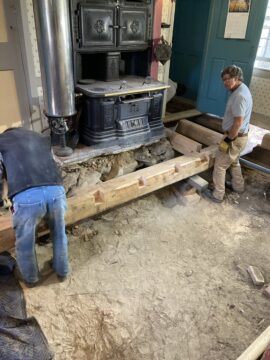
The major change in the wood craftsman’s life was going away to college in Maine, not too far from home, far enough to feel he was getting away but close enough to keep traditional New England architecture within his sight. He would major in industrial arts education because his father had told him, “You would make a good teacher.” For four years he would paint houses and work in the library in Massachusetts in the summer and go back to Maine in the fall to learn about literature and writing, marketing and advertising, along with (of course) woodworking, but also metals, small engine repair, residential construction and electrical installation, architectural design and drafting, just about all the technical fields. He would not go on to teach, however; his gig at student teaching felt like “babysitting,” and he recalls reporting a student who could not even write his name to a supervisor, who told him, “Just move him along.”
After graduating, he needed to find a job and a place to live, and that is when his life’s work fell into his lap. He had been staying at a professor’s house with other students when a neighbor told him about an unoccupied Cape Cod-style house down a road nearby. One of the owners was up from Virginia visiting, so perhaps he could go over and ask her about staying the winter there.
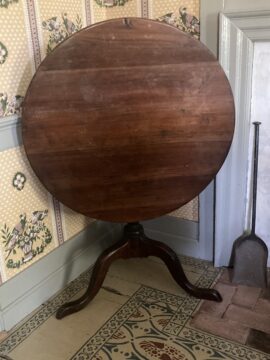
He arrived at Dow Corner in August of 1976 and found the owner and her grown children visiting an unplumbed, unheated, barely wired Maine connected farmhouse that had been not continuously occupied for at least five years. The owner’s family had accommodations at a nearby lake resort and were visiting the house to go through contents that had not been put into storage. The carpenter sat with the owner in the barren parlor and had a nice chat with her. She seemed amenable to his living there over the winter doing maintenance projects on the place — the house had been broken into numerous times and some of its contents stolen. She told him she would have to ask her brother first, though, because as a co-owner of the property he was “funny about these kinds of things.” She told him that after she had talked with her brother and gotten his permission, the newly graduated, homeless carpenter could find house keys at the neighbor’s place across the street.
Having to wait too long to move into a Maine farmhouse with no stoves and no wood in the woodshed in August of the year 1976, (which would turn out to be one of the coldest, snowiest winters in the region’s recorded history), was, to put it mildly, untenable. So, after a few days of no phone calls from the owner, the carpenter went over and introduced himself to the neighbor, said he would be staying in the farmhouse until he heard back from the owners, retrieved the keys, and settled in.
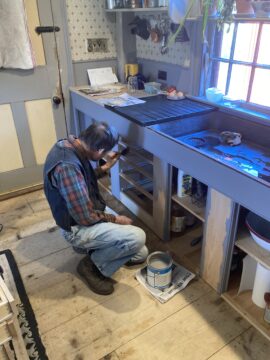
He set about cutting ash trees behind the barn to build up a winter’s supply of firewood, ash being one of the few hardwoods that can burn while still green, albeit miserably. A little while later, the neighbor came over and told him, “The owner called. She said you can live here.” He handed the carpenter a pail containing the piston to the kitchen hand pump, soaking in water to keep the leather gasket from drying out.
The carpenter invited a friend and his girlfriend to be roommates and share chores. In the kitchen they installed an antique cook stove borrowed from the roommate’s grandmother. In the back parlor they installed a makeshift wood stove made from an iron pressure tank.
By October, the roommate’s girlfriend began having second thoughts about living in an uninsulated antique farmhouse over the winter, so the couple left the premises, taking half the firewood they had cut with them.
That winter, the wood craftsman worked at a lumberyard and sawmill during daylight hours building roof trusses and hanging doors, then returned home in the early darkness to get the stoves going for cooking and for making hot water for cleaning up. With half the firewood gone along with the roommates, he ran out of fuel by February, so he would come home from work after dark and cut ash trees behind the barn for burning that night.
Thereafter, he would spend the better part of his summers at Dow Corner cutting plenty of firewood for the season, vowing, “I would never be that cold again.”
[To be continued.]
Wherefore I perceive that there is nothing better, than that a man should rejoice in his own works; for that is his portion: for who shall bring him to see what shall be after him? Ecclesiastes 3:22
This is constructed out of a series of short interviews, and I’ve taken the liberty of simply converting the carpenter’s verbatim statements into third person paraphrases of my own. Having one’s husband as subject permits such license.
*
Images
Photographs by the author.
Enjoying the content on 3QD? Help keep us going by donating now.
